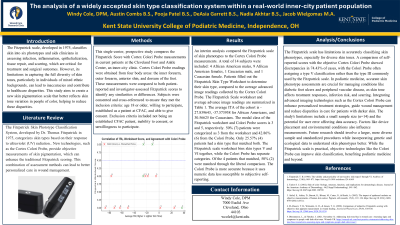Clinical Research
(CR-014) The Analysis of a Widely Accepted Skin Type Classification System Within a Real-world Inner-city Patient Population
Friday, May 2, 2025
7:45 PM - 8:45 PM East Coast USA Time

Nina Kovolyan, CRC – Kent State University
Introduction: The Fitzpatrick Scale, widely used to evaluate skin pigmentation, is a tool developed to assist clinicians in assessing skin infection, inflammation and tissue repair. However, oversimplification and limited representation of diverse skin tones can contribute to healthcare disparities through inaccuracies in diagnosis and delayed treatment leading to poor patient outcomes. Given the diversity and unique demographic characteristics of inner-city populations, it is essential to evaluate how well such classification systems apply in practice.
Methods: This single-center, prospective study compared Fitzpatrick scores with Cortex Colori Probe measurements among patients at the Cleveland Foot and Ankle Center, an inner-city clinic. Cortex Colori Probe readings were taken from four body areas: inner forearm, outer forearm, anterior shin, and dorsum of the foot, and were compared to patient-reported and
investigator-assessed Fitzpatrick scores. Inclusion criteria included established patients 18 years or older, willing to provide informed consent.
Results: An interim analysis of enrolled participants, which included individuals of varying races and ethnicities revealed that only 25.57% of Fitzpatrick scores aligned with the measurements from the Colori Probe. These initial findings highlight the Fitzpatrick scale's limitations and illustrate the Colori Prob’s enhanced sensitivity to variations in skin tone.
Discussion: While skin type classification systems, such as the Fitzpatrick scale, are useful for assessing risk factors for skin conditions and determining appropriate treatments, their relevance in a real-world setting may be limited. Additionally, the underrepresentation of diverse skin tones in medical education, coupled with implicit racial biases among providers, contributes significantly to inequities in medical care, leading to disproportionately poor outcomes for patients of color.
A more nuanced approach that recognizes the complexities of skin health in diverse communities may improve treatment outcomes and better enhance the understanding of dermatological needs.
Methods: This single-center, prospective study compared Fitzpatrick scores with Cortex Colori Probe measurements among patients at the Cleveland Foot and Ankle Center, an inner-city clinic. Cortex Colori Probe readings were taken from four body areas: inner forearm, outer forearm, anterior shin, and dorsum of the foot, and were compared to patient-reported and
investigator-assessed Fitzpatrick scores. Inclusion criteria included established patients 18 years or older, willing to provide informed consent.
Results: An interim analysis of enrolled participants, which included individuals of varying races and ethnicities revealed that only 25.57% of Fitzpatrick scores aligned with the measurements from the Colori Probe. These initial findings highlight the Fitzpatrick scale's limitations and illustrate the Colori Prob’s enhanced sensitivity to variations in skin tone.
Discussion: While skin type classification systems, such as the Fitzpatrick scale, are useful for assessing risk factors for skin conditions and determining appropriate treatments, their relevance in a real-world setting may be limited. Additionally, the underrepresentation of diverse skin tones in medical education, coupled with implicit racial biases among providers, contributes significantly to inequities in medical care, leading to disproportionately poor outcomes for patients of color.
A more nuanced approach that recognizes the complexities of skin health in diverse communities may improve treatment outcomes and better enhance the understanding of dermatological needs.

.jpg)